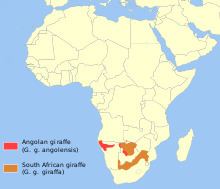Rank Species | Phylum Chordata Order Artiodactyla Genus Giraffa | |
 | ||
Similar Williamson's mouse‑deer, Timor warty pig, Brooke's duiker, Ruwenzori duiker, Bangweulu tsessebe | ||
Southern giraffe
The southern giraffe (Giraffa giraffa) is a species of giraffe native to Southern Africa. It ranges from South Africa, Angola, Namibia, Botswana, Zambia, Zimbabwe, Mozambique. The southern giraffe is one of the four newly discovered members of the genus Giraffa. The species was described and given its binomial name by German naturalist Johann Christian Daniel von Schreber in 1784. Two subspecies are recognized. It has rounded or blotched spots, some with star-like extensions on a light tan background, running down to the hooves. Their approximate population is composed of 44,500 individuals.
Contents
- Southern giraffe
- Southern giraffe in kgalagadi transfrontier park 37 s africa 2016
- Taxonomy and evolution
- Subspecies
- Descriptions
- Distribution and habitat
- Ecology and behavior
- Threats
- References
All giraffes are considered Vulnerable to extinction by the IUCN.
Southern giraffe in kgalagadi transfrontier park 37 s africa 2016
Taxonomy and evolution
Living giraffes were originally classified as one species by Carl Linnaeus in 1758, under the binomial name Cervus camelopardalis. Once considered a subspecies of the conglomerate Giraffa camelopardalis species, recent studies identified the southern giraffe as a separate species of a reorganised Giraffa genus, under the binomial name Giraffa giraffa. Morten Thrane Brünnich classified the genus Giraffa in 1772.
The southern giraffe was known by the binomen Camelopardalis giraffa first described by German naturalist Johann Christian Daniel von Schreber in his publication Die Säugethiere in Abbildungen nach der Natur mit Beschreibungen (The Mammals illustrated from Nature with descriptions) during his travel in the Cape of Good Hope in 1784. Although, it is also stated that Dutch naturalist Pieter Boddaert described and given the binomial name Giraffa giraffa whilst also identifying the Cape specimen under the ternary name Giraffa camelopardalis giraffa in 1785.
Following Schreber's description of the southern giraffe, several specimens were described by other naturalists and zoologists since the end of the 18th century under different scientific names, which are all considered synonyms of Giraffa giraffa today:
Subspecies
Two subspecies of southern giraffe are recognized.
Descriptions
The Cape subspecies of southern giraffe has dark, somewhat rounded patches "with some fine projections" on a tawny background colour. The spots extend down the legs and get smaller. The median lump of males is less developed.
Distribution and habitat
The Southern giraffes live in the savannahs and woodlands of northern South Africa, Angola, southern Botswana, southern Zimbabwe, Zambia and south-western Mozambique. After local extinctions in various places, the South African giraffes have been reintroduced in many parts of Southern Africa, including in Swaziland. They are common in both in and outside of protected areas.
Ecology and behavior
Southern giraffes usually live in savannahs and woodlands where food plants are available. Southern giraffes are herbivorous mammals. They feed on leaves, flowers, fruits and shoots of woody plants such as Acacia.
Threats
Southern giraffes are not a threatened species, as their population is increasing. On the other hand, the South African subspecies are occasionally preyed upon by Transvaal lions especially in Kruger National Park. Giraffe calves can also be preyed upon by African leopards, hyenas and Cape wild dogs.
